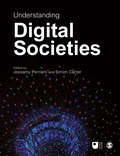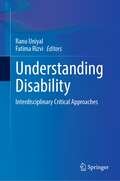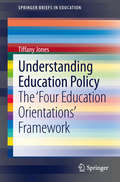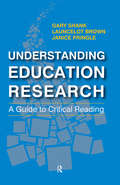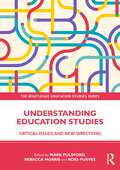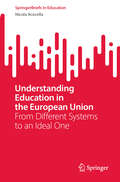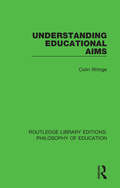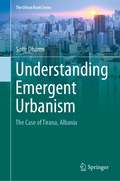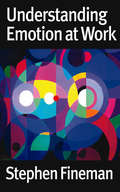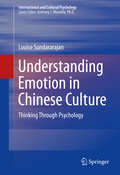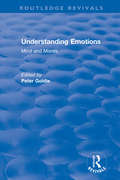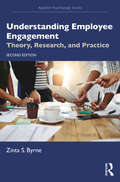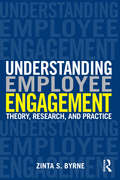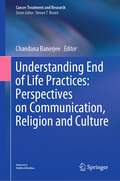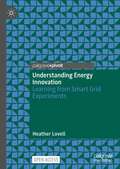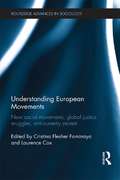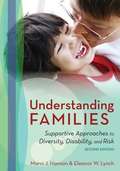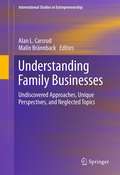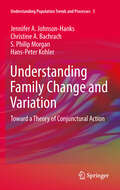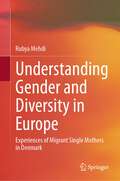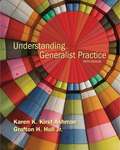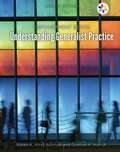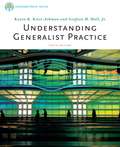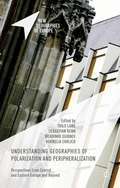- Table View
- List View
Understanding Digital Societies (Published in association with The Open University)
by Simon Carter Jessamy PerriamUnderstanding Digital Societies provides a framework for understanding our changing, technologically shaped society and how sociology can help us make sense of it. You will be introduced to core sociological ideas and texts along with exciting global examples that shed light on how we can use sociology to understand the world around us. This innovative, new textbook: Provides unique insights into using theory to help explain the prevalence of digital objects in everyday interactions. Explores crucial relationships between humans, machines and emerging AI technologies. Discusses thought-provoking contemporary issues such as the uses and abuses of technologies in local and global communities. Understanding Digital Societies is a must-read for students of digital sociology, sociology of media, digital media and society, and other related fields.
Understanding Disability: Interdisciplinary Critical Approaches
by Ranu Uniyal Fatima RizviThis edited volume brings together contributions on disability studies organized around two themes: literary and sociological aspects. The contributors include academics, disability activists, and researchers from within and outside the Indian periphery. While the book strengthens the disability discourse and contributes to building academic scholarship on this subject, it also promotes disability activism by giving space to both direct practitioners and persons with disabilities. The chapters discuss various analytical and literary aspects of the marginalization experienced by the disabled community and bring forth new and elaborate perspectives. It draws connections across multiple identities and includes personal narratives across nations, cultures and societies. It is an excellent research resource on disability studies in India for scholars and students in the area of humanities, education, law, sociology and social work, while at the same time also addressing the global context.
Understanding Education Policy
by Tiffany JonesAnalysis of education policy often follows a particular orientation, such as conservative or neo-liberal. Yet, readers are often left to wonder the true meaning and conceptual framing behind these orientations. Without this knowledge, the policy analysis lacks true rigor, its value is diminished as the results may prove difficult to reproduce. Understanding Education Policy provides an overarching framework of four key orientations that lie beneath much policy analysis, yet are rarely used with accuracy: conservative, liberal, critical and post-modern. It details each orientation's application to policy making, implementation and overall impact. The book also argues the value of analysing a policy's orientation to improve the clarity of its analysis and allow broader trends across the education policy field to emerge. The book offers practical examples, key vocabulary and reflection activities which give equitable, yet critical consideration to all education orientations. This allows readers to see the benefits and disadvantages of each perspective and discover their own biases. This introduction to education policy analysis offers theoretically broad, highly practical coverage. It is adaptable to many kinds of policy analysis areas and will appeal to a wide range of readers with an interest in education policy, from students conducting specific research to policy makers looking for a deeper way to re-think their work.
Understanding Education Research: A Guide to Critical Reading
by Launcelot Brown Gary Shank Janice Pringle"Understanding Education Research" is designed to help students learn to read educational research articles carefully, systematically, and critically. Students learn to categorize titles, decode abstracts, find research questions, characterize research arguments, break down methods and procedures, explore references, apply analysis strategies, and interpret findings. The book allows them to easily develop the skills they need to be research literate. It offers simple guidelines for qualitative, quantitative, and statistical approaches that help students master the basics behind these often complex and confusing methodologies. The book is accessible for future researchers or for students who simply need to understand research clearly. It is written in a clear and engaging style, with ample concrete examples of each stage, offering exercises for student practice.
Understanding Education Studies: Critical Issues and New Directions (The Routledge Education Studies Series)
by Mark PulsfordThis book explores undergraduate education programmes in a new way. Written by those at the forefront of teaching and learning, it encourages students to delve beneath the surface of their degree subject and reveals important insights about the how, why and where next for education studies. With contributions from course leaders, tutors, current students and recent graduates, this book offers insights from nearly 60 authors based in 20 different institutions from five different countries. The chapters offer opportunities for readers to consider their own learning experiences in a wider context, enhance their understanding of the degree course and actively shape the education studies community of the future. Each chapter is written in an accessible way, with ‘questions to consider’ throughout and ‘recommended readings’ at the end to advance readers’ thinking and reflections. Chapters cover topics such as: Education Studies’ development as a degree subject Its evolving identity, values and purposes Teaching and assessment approaches in undergraduate education programmes How the subject develops students’ professional aptitudes and transferable skills Possibilities for advancing inclusion, equity and justice in education at degree level These ‘behind the scenes’ factors are brought to the fore through case studies and examples of how lecturers and students make sense of their teaching and learning. With its unique approach to examining these issues, this book is essential for students of Education Studies at undergraduate level while also being relevant for staff and postgraduate students in education.
Understanding Education in the European Union: From Different Systems to an Ideal One (SpringerBriefs in Education)
by Nicola AcocellaThis book examines the importance of education in the European context, from knowledge acquisition to its instrumental nature. It provides a short history of education of schools around the world before delving into the comparisons of European education systems through exploration of their organization, teaching methods, attendance models and public versus private provision and costs. Additionally, it discusses the existence of NEETs (Not in Education, Employment, or Training) within these systems. Starting with addressing the six dimensions of the European Education Area devised by the Bologna Process, it concludes with identifying a need for a superior education model that accommodates different aspects of education which is not yet satisfactorily achieved by any existing systems, offering insight into an ideal education system. Inviting reflection on the role of education and its future, educators, educational administrators, and those interested in understanding and improving the functioning of schools find this book of great value.
Understanding Educational Aims (Routledge Library Editions: Philosophy of Education #21)
by Colin WringeThis text, first published in 1988, examines the underlying rationale of educational aims as applied to individual pupils, social policies and supposedly intrinsic values. This book explores traditional educational aims such as developing the potential and autonomy of individuals or the promotion of rationality as well as more contemporary and often controversial ones. The author provides a clear and balanced justification of educational aims which teachers need in order to combat the rhetoric of changing fashion or the pressures of political and managerial opportunism. This book is essential reading both for students and teachers.
Understanding Emergent Urbanism: The Case of Tirana, Albania (The Urban Book Series)
by Sotir DhamoThe ideas presented in this book are a conceptual leverage to correct the rigidity of top-down practices and bring the real city, or the city of everyday life, closer to the city of conventional planning. Considering self-organization as the starting point at the base of complex systems, this book tries to understand how specific qualities emerge and evolve from this behavior. For this, the book discusses new ways of looking at and understanding cities by applying holistic methods and approaches based on the conceptual grounds of quantum, fractal, and complexity theories. The book highlights the fact that the information on how to transform and build a city is contained within the city itself. In this regard, some methodological steps to unpack complexities and translate the essential qualities of space into potential generators for city design and planning are provided. The book urges courageous experimentation and proposes a methodology where the computational nature of urban phenomena goes along with historic anthropological ideas, thus emphasizing the characteristics of a specific reality in a model. They do not exclude each other; in fact, they are part of the unbroken web of wholeness. Importantly, the proposed methodology supports gradual and natural coevolution process in the city through combining planned and unplanned actions and the involving multiplicity of actors, impacting on Urban Planning and Design Practice.
Understanding Emotion at Work: Sias, Organizing Relationships + Fineman, Understanding Emotion At Work
by Stephen Fineman`Most folks in organizations dichotomize reason and emotion, often treating emotion as an uncommon or marginal occurrence. Written in a clear and lively style, Steve Fineman's book, Understanding Emotion at Work, dispels this notion as he demonstrates how emotions infuse most practices in organizational life, including leading, decision making, organizational change, gender relations, stress, and downsizing. Sprinkled with vivid examples, Fineman captures the positive benefits of emotions at work as well as the darker side of feelings and despair. Scholars, students and practitioners alike will glean important insights from the lens of emotion that Fineman brings to the subtleties of organizational life' - Linda L Putnam, Texas A&M University `Stephen Fineman has written a wise and engaging text about emotions and how they play out in and around organizations. He underscores, with a range of fine examples, thoughtful commentary and careful scholarship, the essential role of emotions in organizational life. He applies his lens to such issues as recruitment, leadership, decision making and change. He extends the reach of emotions into the virtual world of work and he makes apparent the heavy costs to people and their organizations of toxic emotions that stem from bullying,harassment and downsizing. A must-read in any curriculum dealing with the study of organization' - Peter Frost, Edgar F. Kaiser Professor of Organizational Behaviour, Faculty of Commerce and Business Administration, University of British Columbia, Canada Author of Toxic Emotions at Work HBS Press 2003 `Going to work can be a great joy, a great pain, or a mixture of the two. This clearly written, engaging and authoritative book demonstrates the vital necessity of understanding how emotions permeate work organisations at every level and in every situation. No student of work and its organisation can afford to neglect this important area of study. And no writer on work and organisation is better placed to go to the heart of these matters than Stephen Fineman' - Professor Tony J Watson, Professor of Organisational and Managerial Behaviour, Nottingham Business School `In this book, Professor Stephen Fineman has done more of what he does best writing eloquently and perceptively about emotions in organizations. In this case, he is writing directly for students, both undergraduates and postgraduates, and uses a wide range of disciplinary insights to show how emotions are inextricably embedded in organizational life. His book helps to launch students on a voyage of self-discovery to learn for themselves how emotions impact upon them and their colleagues. As someone who has long challenged the "emotion-less" view of emotion that characterizes much of the research on this phenomenon, he uses his considerable skills to convey the importance, richness and nuance of emotion. Nor does he shrink away from tackling the darker side of organizational emotional life challenging students to reflect on the agony, as well as the ecstasy, that passionate emotions can cause. This book is a valuable resource for teachers wanting to introduce students to organizations, and a fascinating and astute aid for students interested in learning about them - Professor Cynthia Hardy, Department of Management, University of Melbourne `Organizational life is shot through with emotions, spawning a growing interest in topics ranging from emotional intelligence to violence at work. Stephen Fineman provides a much-needed survey of these topics, capturing their sprawling breadth without sacrificing depth. Moreover, he succeeds in conveying the everyday feel of emotions in organizational life in a way that is both engaging and informative' - Blake Ashforth, Jerry and Mary Ann Chapman Professor of Business, W P Carey School of Business, Arizona State University Understanding Emotion at Work gets to the heart of what binds and breaks organizations: emotion. It explores beyond the surface of work to the rich emotional life bubbling underneath, showing what employees and managers constantly ...
Understanding Emotion in Chinese Culture
by Louise SundararajanThis mind-opening take on indigenous psychology presents a multi-level analysis of culture to frame the differences between Chinese and Western cognitive and emotive styles. Eastern and Western cultures are seen here as mirror images in terms of rationality, relational thinking, and symmetry or harmony. Examples from the philosophical texts of Confucianism, Daoism, Buddhism, and classical poetry illustrate constructs of shading and nuancing emotions in contrast to discrete emotions and emotion regulation commonly associated with traditional psychology. The resulting text offers readers bold new understandings of emotion-based states both familiar (intimacy, solitude) and unfamiliar (resonance, being spoiled rotten), as well as larger concepts of freedom, creativity, and love. Included among the topics: The mirror universes of East and West. In the crucible of Confucianism. Freedom and emotion: Daoist recipes for authenticity and creativity. Chinese creativity, with special focus on solitude and its seekers. Savoring, from aesthetics to the everyday. What is an emotion? Answers from a wild garden of knowledge. Understanding Emotion in Chinese Culture has a wealth of research and study potential for undergraduate and graduate courses in affective science, cognitive psychology, cultural and cross- cultural psychology, indigenous psychology, multicultural studies, Asian psychology, theoretical and philosophical psychology, anthropology, sociology, international psychology, and regional studies.
Understanding Emotions: Mind and Morals (Routledge Revivals)
by Peter GoldieThis title was first published in 2002: At the end of the 20th century, the emotions ceased to be a neglected topic for philosophical consideration. The editor suggests that this may, in part, be due to a change in the way the subject is approached. The emotions were characteristically thought of by philosophers as states which give rise to perturbation in what might roughly be called "right-thinking". The basic idea was that practical reasoning, like theoretical reasoning, ought to be, and can be, dispassionate. This means that either the emotions interfere with "right-reasoning" in a way which is a proper object of study for the biological sciences but not for the science of the mind, or that the emotions become reducible to, and analyzable as, collections of propositional attitudes which are themselves assessable in terms of "right-reasoning". The move away from this idea is taken as an improvement in our philosophical approach to the emotions by the authors. Following this, all of the papers in the volume contribute to this philosophical approach, each approaching the subject from a different angle.
Understanding Employee Engagement: Theory, Research, and Practice (Applied Psychology Series)
by Zinta S. ByrneUnderstanding Employee Engagement is a comprehensive source for the science and practice of employee engagement. This book provides a rigorous and objective review of scholarship and empirical research on engagement from around the world. Grounded in theory and empirical research, this book debates the definitions of engagement, provides a thorough evaluation of empirical findings in the engagement field including a focus on international findings, and offers practice implications for organizations. The book is broad, with references and research across disciplines and countries, as well as new sections addressing current challenges, such as virtual engagement, engaging the aging workforce, and perspectives on diversity and inclusion. Employers can learn how to foster an engaged organization; practitioners can learn how to measure, identify, and implement evidence-based solutions to disengagement; and researchers can master the existing engagement literature and begin to study the many propositions and new models the author proposes throughout the book. This book is an essential read for scholars, researchers, practitioners, and business leaders alike for understanding how to measure, identify, and implement evidence-based solutions to foster employee engagement.
Understanding Employee Engagement: Theory, Research, and Practice (Applied Psychology Series)
by Zinta S. ByrneEmployee engagement is a novel concept that has been building momentum in recent years. Understanding Employee Engagement: Theory, Research, and Practice exposes the science and practice of employee engagement. Grounded in theory and empirical research, this book debates the definitions of engagement, provides a comprehensive evaluation of empirical findings in the engagement field including a focus on international findings, and offers implications for science and practice in organizations. Employers can learn how to foster and drive engagement to increase productivity and happiness, and researchers can master the existing engagement literature and begin to study the many propositions and new models Zinta S. Byrne, Ph.D. proposes throughout the book.
Understanding Employee Engagement: Theory, Research, and Practice (Applied Psychology Series)
by Zinta S. ByrneUnderstanding Employee Engagement is a comprehensive source for the science and practice of employee engagement. This book provides a rigorous and objective review of scholarship and empirical research on engagement from around the world. Grounded in theory and empirical research, this book debates the definitions of engagement, provides a thorough evaluation of empirical findings in the engagement field including a focus on international findings, and offers practice implications for organizations. The book is broad, with references and research across disciplines and countries, as well as new sections addressing current challenges, such as virtual engagement, engaging the aging workforce, and perspectives on diversity and inclusion. Employers can learn how to foster an engaged organization; practitioners can learn how to measure, identify, and implement evidence-based solutions to disengagement; and researchers can master the existing engagement literature and begin to study the many propositions and new models the author proposes throughout the book. This book is an essential read for scholars, researchers, practitioners, and business leaders alike for understanding how to measure, identify, and implement evidence-based solutions to foster employee engagement.
Understanding End of Life Practices: Perspectives on Communication, Religion and Culture (Cancer Treatment and Research #187)
by Chandana BanerjeeThis book is an exploration of issues that are essential in end of life care. Understanding end of life practices across cultures and religions is important in the delivery of patient centered end of life care. This book helps clinicians and non-clinicians understand the various end of life practices in their vast patient populations, further contributing to providing empathetic and compassionate end of life care to patients. With the advent of many new options at the end of life, this book also explores the modern day approaches to end of life often sought by patients when faced with disease progression and adversity.
Understanding Energy Innovation: Learning from Smart Grid Experiments
by Heather LovellThis open access book uses smart grids to explore and better understand energy innovation, from a social science perspective. Understanding Energy Innovation has four core themes—networks, nodes, narratives and nostalgia—and each chapter tackles a theme, using case studies from Australia and Europe. Energy innovation is currently occurring at a rapid pace, in response to a host of problems including climate change, high energy prices, and unreliable supply. Understanding Energy Innovation provides ways to think about and plan for energy sector reform and innovation, drawing on core ideas from social and innovation theory, and centred on smart grids as a case study. These academic ideas are written about in an accessible way, recognising that a diversity of people have an interest in energy innovation generally, and smart grids more specifically, and would like to find out more about ways of understanding energy innovation that integrate the social and the political.
Understanding European Movements: New Social Movements, Global Justice Struggles, Anti-Austerity Protest (Routledge Advances in Sociology)
by Laurence Cox Cristina Flesher FominayaEuropean social movements have been central to European history, politics, society and culture, and have had a global reach and impact. Yet they have rarely been taken on their own terms in the English-language literature, considered rather as counterpoints to the US experience. This has been exacerbated by the failure of Anglophone social movement theorists to pay attention to the substantial literatures in languages such as French, German, Spanish or Italian – and by the increasing global dominance of English in the production of news and other forms of media. This book sets out to take the European social movement experience seriously on its own terms, including: the European tradition of social movement theorising – particularly in its attempt to understand movement development from the 1960s onwards the extent to which European movements between 1968 and 1999 became precursors for the contemporary anti-globalisation movement the construction of the anti-capitalist "movement of movements" within the European setting the new anti-austerity protests in Iceland, Greece, Spain (15-M/Indignados), and elsewhere. This book offers a comprehensive, interdisciplinary perspective on the key European social movements in the past forty years. It will be of interest for students and scholars of politics and international relations, sociology, history, European studies and social theory.
Understanding Families: Supportive Approaches to Diversity, Disability, and Risk
by Eleanor W. Lynch Marci J. HansonThis book is about families in their many forms, their strengths and challenges, and the ways in which human service professionals can extend their effectiveness by working in partnership with families. This book is based on the authors' beliefs about families and the essential role that family members play in intervention. The textbook is a comprehensive guide to working effectively and respectfully with contemporary families.
Understanding Family Businesses
by Malin Brännback Alan CarsrudBusinesses owned and operated by families constitute the vast majority of firms around the world. These firms are found in all industrial segments, from retail and service establishments to heavy manufacturers. Their sizes and revenues range from the smallest venture of a husband and wife roadside food stall in rural India to the largest multinational, highly diversified corporations in the United States and Europe. Many challenges, such as competition, regulation, environmental concerns, access to capital, and macroeconomic factors confront family and nonfamily firms alike. In addition, family and closely-held firms grapple with such issues of succession, continuity, conflict resolution, identity and organizational roles, estate and financial planning that are idiosyncratic to them; when psychological, social, and emotional factors are in play, constantly changing familial relationships influence the strategic and financial choices they make. Yet, there has been comparatively little theoretical or empirical research undertaken on family firms, relative to entrepreneurship and strategic management. This book addresses gaps in the literature by presenting a holistic, multi-disciplinary approach to the study and practice of family business that draws from such fields as psychology, anthropology, sociology, strategy, family therapy, family studies, wealth management, and international business. An international array of experts addresses both macro issues (including the role of family businesses in new business creation and economic development, influences of culture on family business, public policies that can encourage or threaten family business) and firm management (strategic and financial decision making, governance, entering and exiting). Featuring case studies from firms in a variety of industries, Understanding Family Businesses not only offers provocative new insights on family business dynamics, but outlines an agenda for future research.
Understanding Family Change and Variation
by Hans-Peter Kohler Pamela Smock Christine A. Bachrach Lynette Hoelter S. Philip Morgan Rosalind King Jennifer A. Johnson-HanksFertility rates vary considerably across and within societies, and over time. Over the last three decades, social demographers have made remarkable progress in documenting these axes of variation, but theoretical models to explain family change and variation have lagged behind. At the same time, our sister disciplines--from cultural anthropology to social psychology to cognitive science and beyond--have made dramatic strides in understanding how social action works, and how bodies, brains, cultural contexts, and structural conditions are coordinated in that process. Understanding Family Change and Variation: Toward a Theory of Conjunctural Action argues that social demography must be reintegrated into the core of theory and research about the processes and mechanisms of social action, and proposes a framework through which that reintegration can occur. This framework posits that material and schematic structures profoundly shape the occurrence, frequency, and context of the vital events that constitute the object of social demography. Fertility and family behaviors are best understood as a function not just of individual traits, but of the structured contexts in which behavior occurs. This approach upends many assumptions in social demography, encouraging demographers to embrace the endogeneity of social life and to move beyond fruitless debates of structure versus culture, of agency versus structure, or of biology versus society.
Understanding Gender and Diversity in Europe: Experiences of Migrant Single Mothers in Denmark
by Rubya MehdiThis book is a socio-legal interdisciplinary study on gender and diversity in multicultural societies of Europe. It uses secondary data to discuss the broad experiences of migrant single mothers/women in Europe. Second, it includes narratives of experiences across the life course of single Danish-Pakistani women, starting from their pre-migration background to their elderly lives. The author uses an analytical framework used of relational collectivism and individualism, the former referring to the understanding of oneself as connected and interdependent to the family, and the latter referring to values of independence, personal interest and achievements. She uses the term “mélange familism” to explain a new family type that combines both relational-collectivist and individualist elements. A major part of this work is its deliberation of mélange familism and processes of social and legal practices in the everyday lives of single mothers. Crucially, the book demonstrates that social and legal traditions are not static, but are a product of improvisation. It makes a significant contribution by providing an alternate picture of single women/mothers as against the stereotypical image of ‘passive, subordinate Muslim women’. It also contributes to gender and family studies by showing the increasing establishment of single-mother-headed households as a source of new possibilities; a new type or form of family construction, and not just the tragic residue of a broken two-parent family.
Understanding Generalist Practice (5th edition)
by Karen K. Kirst-Ashman Grafton H. HullNew edition of a text that provides a framework for social work students to view the world from a generalist perspective. Emphasizing a core of micro-skills, Kirst-Ashman (U. of Wisconsin-Whitewater) and Hull (U. of Utah) present 16 chapters that discuss relationship-building, interviewing, and problem-solving abilities necessary for working with individual clients. They also orient students to think not only in terms of individual needs but also of group and community needs. New focus points include cultural competency, empowerment of people with disabilities, interviewing children in the context of abuse, updated information on substance abuse, and confidentiality with respect to electronic record-keeping. Annotation c. Book News, Inc., Portland, OR (booknews.com)
Understanding Generalist Practice (Mindtap Course List Series)
by Karen K. Kirst-Ashman Grafton H. HullOrganized around the coherent and cohesive Generalist Intervention Model, this guide to generalist social work practice incorporates the knowledge, skills, and professional values you need to work with individuals and families, as well as the foundation to work with groups, communities, and organizations. Updated to reflect current topics and practice, the book focuses on micro levels of social work practice while also discussing the interrelationship among the micro, mezzo, and macro levels. Part of the Brooks/Cole Empowerment Series, UNDERSTANDING GENERALIST PRACTICE, 8th Edition, clearly identifies content related to the latest Council on Social Work Education (CSWE) Educational Policy and Accreditation Standards (EPAS) with icons throughout the text. Learning objectives, which are correlated to chapter headings and summaries, guide your reading and reinforce your understanding.
Understanding Generalist Practice (Sixth Edition)
by Karen K. Kirst-Ashman Grafton H. Hull Jr.Organized around the authors' coherent and cohesive Generalist Intervention Model, this introductory guide to generalist social work practice provides users with the knowledge and skills they will need to work with individuals and families, as well as the foundation to work with groups, communities, and organizations. It explores the links between micro, mezzo, and macro levels of social work practice and reflects the latest EPAS standards with empowerment and strengths perspectives for partnering with clients.
Understanding Geographies of Polarization and Peripheralization: Perspectives From Central And Eastern Europe And Beyond (New Geographies Of Europe)
by Thilo Lang Sebastian Henn Wladimir Sgibnev Kornelia EhrlichThis book presents a multifaceted perspective on regional development and corresponding processes of adaptation and response, focusing on the concepts of polarization and peripheralization. It discusses theoretical and empirical foundations and presents several compelling case studies from Central and Eastern Europe and beyond.
